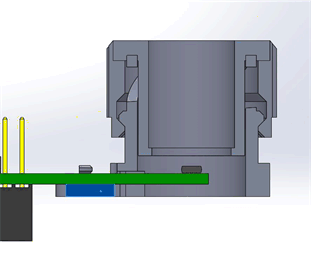SBAA463A january 2021 – april 2023 TMAG5170 , TMAG5170-Q1 , TMAG5170D-Q1 , TMAG5173-Q1 , TMAG5273
4.1.1 Evaluating Design Constraints
To sufficiently demonstrate the performance of both the A1 and A2 variant of TMAG5170, it was determined that the input magnetic flux density should be close to full scale input for the highest range of the TMAG5170A1.
A knob with 1-in diameter was designed so that it could provide something substantial enough to manipulate while keeping the solution small enough to comfortably ship with the EVM packaging. As a result, the available opening for any magnet needed to be roughly 1/2 in.
 Figure 4-1 TMAG5170 Push-Button Knob
Attachment
Figure 4-1 TMAG5170 Push-Button Knob
Attachment